
Now 10% off all Ergolash lashing straps save now! Voucher code: ergo10 | Valid until 31.05.2025
The use of dunnage bags in containers is a common method and has become an integral part of the repertoire of securing methods. Nevertheless, it is a method whose effectiveness is obvious, but which is also associated with risks.
The CTU Code devotes an entire chapter to stowage cushions in Appendix 7, Annex 4, and is packed with formulas that at first glance seem to overwhelm the normal shipper/consignor. It therefore seems appropriate to shed some light on the subject and explain the logic contained therein.
In general, dunnage bag serves to close existing gaps between cargo units in the container and to transfer the resulting acceleration forces of the cargo to the container walls without interruption.
Two approaches are described:
1. How large must a dunnage bag be in order to prevent a load of known weight from moving under defined accelerations and friction coefficients?
2. What load forces can a dunnage bag with known dimensions and filling pressure absorb?
Corresponding formulas for both questions can be found in the CTU Code.
The formulas on the right are used to calculate the charge force that arises under certain accelerations and friction coefficients.
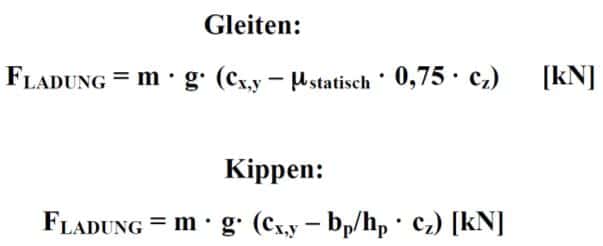
The following considerations are again based on the classic block of five Euro pallets.
We assume a load weight of 2x 900kg for the lengthwise standing ones and 3x 800kg for the crosswise standing ones. Depending on the rolling angle, 1,800 kg or 2,400 kg must be assumed.
The CTU Code stipulates that the higher load weight must be used in each case.
We assume the following additional factors:
Xy = 0.8g Acceleration during rolling
Cz = 0.2 Acceleration during pitching
μ = 0.3 Coefficient of friction on the container floor
SF = 0.75 Safety factor for padding for 1x use
Mass = 2.4t or
Mass = 2,400kg
Acceleration due to gravity = 9.81m/s2 ~ 10 m/s2
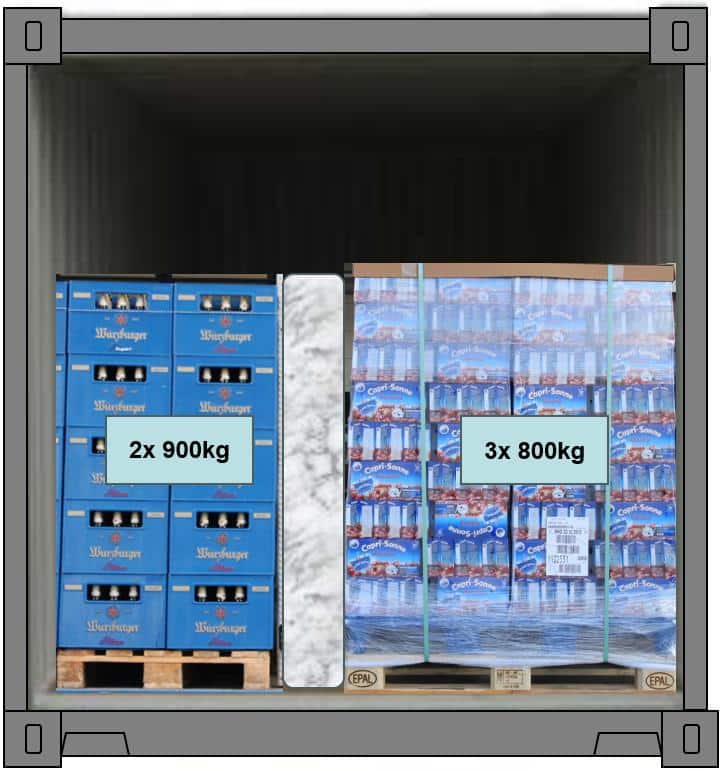
The calculation can also be simplified for practitioners who are more familiar with the unit “daN”. The example calculation is intended to show this. The first line calculates with tons and the second with kilograms. To convert from kN to daN, the result must first be multiplied by 1,000 and then divided by 10. If you take the weight of the load in kg and calculate the acceleration due to gravity as 1, you have the result in daN in one calculation.

Result: The cushion must be able to absorb a load force of 1,812daN.
Appendix 7, Annex 4, Chapter 4.3 calculates the force that a dunnage bag can absorb depending on the burst pressure. The formula must be rearranged to determine the contact area of the bumper:
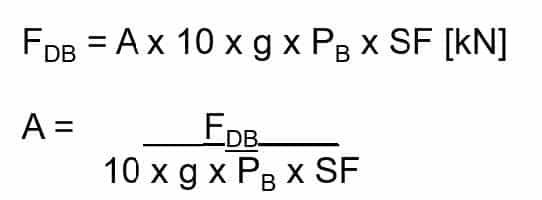
Using the load force from the example above, the dunnage bag must have a surface area of 0.45m2 to absorb the force.
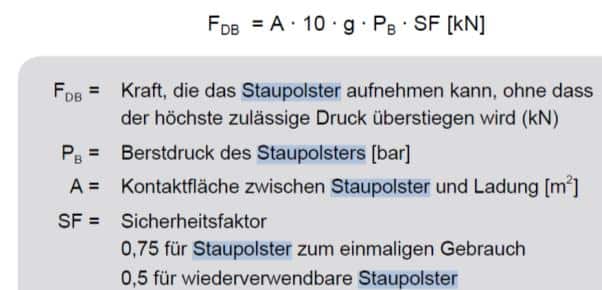

To continue working with the example, let’s imagine the whole thing from above.
Container internal width = 2.34m
Euro pallet: 0.80 x 1.20m
In purely mathematical terms, this results in the following gap width:
2.34m – 0.80m – 1.20m = 0.34m
and a gap length of 2.40m.
If we assume the height of the pallets to be 1.60m, this would result in a maximum padded area of: 1.60m x 2.40m = 3.84m2.
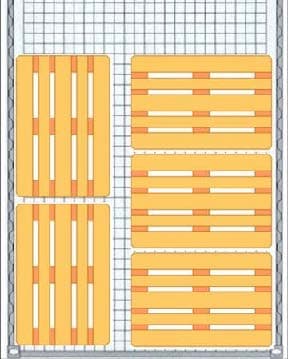
If we assume that a pad should not only absorb the load force, but also secure the entire load against twisting/sliding, then a pad length of 2.00 m would be sufficient. Assuming that the pallets are also stable in height, the pad height could be reduced to 1.40m.
The effective pad area of 2.00m x 1.40m = 2.80m2.
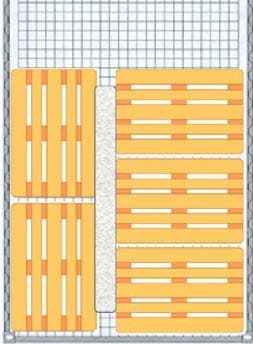
If we now compare the two calculated results, namely the 0.45 m2 required by the cargo weight with the area resulting from the cargo dimensions, namely 2.80 m2 , we obtain 6 times the safety factor.
The calculated figures show that a cushion that is dimensioned according to the load can generally absorb considerably more load force than is actually required. This also leads to the conclusion that a high filling pressure is not necessary. The use of dunnage bags requires a lot of air but little pressure. Filling via a compressed air system takes more time than with a blower. Provided that no other technical mistakes are made, you are always on the safe side.
Of course, it is always necessary to consult with the supplier of dunnage bag and request the specific handling data.
The above description also shows that, despite its many formulas, the CTU code is not as complicated as it appears at first glance. So don’t be afraid to take a closer look at the rules.
Yours, Sigurd Ehringer
<< Previous article
Episode 47: Is it necessary to secure loads at the top of the container?
To the next post >>

Sigurd Ehringer
✔ VDI-zertifizierter Ausbilder für Ladungssicherung ✔ Fachbuch-Autor ✔ 8 Jahre Projektmanager ✔ 12 Jahre bei der Bundeswehr (Kompaniechef) ✔ 20 Jahre Vertriebserfahrung ✔ seit 1996 Berater/Ausbilder in der Logistik ✔ 44 Jahre Ausbilder/Trainer in verschiedenen Bereichen —> In einer Reihe von Fachbeiträgen aus der Praxis, zu Themen rund um den Container und LKW, erhalten Sie Profiwissen aus erster Hand. Wie sichert man Ladung korrekt und was sind die Grundlagen der Ladungssicherung? Erarbeitet und vorgestellt werden sie von Sigurd Ehringer, Inhaber von SE-LogCon.
Rothschenk assortment
Our customer center has only one goal: to turn your problems into solutions. Whether standard stowage cushions, bestsellers or load securing personally tailored to your needs -. we accompany you consistently from A as in field service to Z as in certification. That is our promise to you, as a leader in our industry.
We attach great importance to professional cargo securing. That is why we have our own production, which ensures reliable operation through modern manufacturing technologies and strict quality control. Thus, we offer our customers a comprehensive and high-quality range of services in the field of transport logistics.
DIN ISO 9001:2015, EMAS and Ecovadis are not foreign words to you? Then it's time to work with the best.
You don't take any risks with us - we have been awarded the Platinum Medal on the EcoVadis sustainability rating platform.
As a load securement company, we are proud to have several certifications that validate our sustainability efforts and our commitment to environmental protection and social responsibility. For you as a purchaser, this means that we demand and promote the implementation of high environmental and social standards both within the company and along the supply chain.
You are currently viewing a placeholder content from Google Maps. To access the actual content, click the button below. Please note that doing so will share data with third-party providers.
More Information